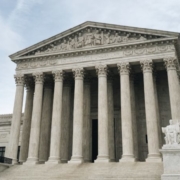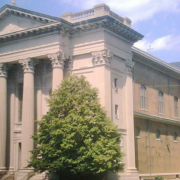According to secular news reports about Brebeuf Jesuit High School in Indianapolis, which Archbishop Charles Thompson declared to be no longer Catholic, you’d think the decision was all about the Church’s eagerness to fire a “gay” teacher.
Likewise, articles about Cathedral High School in northeast Indianapolis, which upheld its Catholic identity by dismissing one of its teachers, also emphasize the teacher’s sexuality.
Such is “fake news”—it’s rooted in some fact, but not in truth. In fact, the Indianapolis situation is primarily about a Catholic school’s obligations to teach the faith clearly and without contradiction.
The Indianapolis Star proclaimed, “Indianapolis Archdiocese Cuts Ties with Jesuit School Over Refusal to Fire Gay Teacher.” FOX News claimed Brebeuf was “Stripped of ‘Catholic’ Label Over Gay Teacher.” Newsweek announced that Cathedral “Fires Gay Teacher,” and the USA Today headline likewise reported that Cathedral “Is Firing a Gay Teacher.”
And now, a New York Times contributor has lectured the bishops on the need to defend our “L.G.B.T.Q. brothers and sisters.” The article is titled, “How to Defy the Catholic Church.”
To be sure, at both Brebeuf and Cathedral the teachers under scrutiny are identified as “gay”—but what caused the controversy is not that directly, but instead their public actions contradicting what they are supposed to be teaching in a Catholic school. Both entered into civilly approved same-sex marriages. Such public scandal makes someone ineligible to teach in a genuinely Catholic school, and this would be true of scandal leading children into any type of grave sin, whether homosexual or otherwise.
Indeed, both teachers had been employed despite apparent awareness of their sexuality, so the claim of discrimination is ludicrous. Public identification as “gay” can be scandalous, if sexuality is touted in such a way as to lead young people into sin. But this is not why the Archdiocese of Indianapolis raised concerns about the teachers at Brebeuf and Cathedral, and apparently no employee’s job was at risk because of private struggles with sexuality.
Still, the secular media and activists like Jesuit Fr. James Martin have deliberately characterized the Archdiocese as targeting people for their “sexual identity.” This falsehood stirs up the crowd to persecute the Body of Christ, with claims of discrimination and attempts to erode religious freedom.
Witnesses to the Faith
Such discrimination claims are wrong. Central to Brebeuf’s tragic loss of Catholic identity are the school’s failure to insist that teachers publicly witness to the Catholic faith, its betrayal of families who rely on Catholic education to uphold Catholic teachings, and the school’s refusal to abide by the rightful authority of Archbishop Thompson to establish expectations for Catholic schools in his diocese.
A Catholic school exists for the purpose of forming young people for the fullness of humanity, all that God intends for them. This includes formation in the Catholic faith, indeed in all truth about God, man and reality.
It is essential, then, that teachers in Catholic schools present the truth clearly in both word and deed. Their witness can powerfully reinforce Christian formation—or it can be dangerously destructive by misleading a child into falsehood.
This can be a real challenge for Catholic schools in a highly secularized and sexualized society, in which even well-intentioned Catholic teachers are confused about moral truth and may be poorly catechized.
“In today’s pluralistic world, the Catholic educator must consciously inspire his or her activity with the Christian concept of the person, in communion with the Magisterium of the Church” (Lay Catholics in Schools: Witnesses to Faith, 1982, 18). An authentic Christian anthropology, of course, recognizes only two sexes and understands sexuality in the context of chastity and matrimony between a man and woman.
While a Catholic school is a Christian community full of mercy and compassion for its members who may struggle to live good and holy lives, it is essential to the work of the school that teachers not publicly challenge or contradict the Catholic faith in which students are being formed.
Canon law is clear: “The instruction and education in a Catholic school must be grounded in the principles of Catholic doctrine; teachers are to be outstanding in correct doctrine and integrity of life” (Canon 803 §2). It is essential that Catholic schools explain to employees precisely what that means, by including “morality clauses” in teacher contracts. The Cardinal Newman Society compiled model language here that can be adopted by individual schools and dioceses.
A lesson for teachers
In his announcement that Brebeuf is no longer Catholic, Archbishop Thompson has reaffirmed what the Church has always expected from Catholic schools. And Brebeuf’s consequence was not caused by the bishop: it was the school leaders’ decision not to comply with the Archbishop’s requirements for all Catholic schools, and they chose to stand with the teacher in public contradiction to the Catholic faith. Cooperating with such public contradiction implies dissent, whether or not the school’s leaders actually agree or disagree with Church teaching.
In the past, Catholic schools were largely staffed by clergy and religious. Although there remain some priests, brothers and sisters — notably the Dominican Sisters of Mary, Mother of the Eucharist and the Nashville Dominicans who set such a wonderful example — they make up less than 3 percent of America’s Catholic school teachers.
Therefore, in the last several decades it’s been up to the laity to take up evangelization by Catholic education, serving as ministers of the faith in word and deed. Archbishop Thompson recognizes the influential role that teachers play in the formation of students.
No teacher in a Catholic schools is sinless. But teachers should do everything possible to grow in virtue and avoid scandal, with special attention to persistent, public scandals that are most damaging to students. Catholic schools should ensure that they have qualified teachers who are able to fulfill the job of aiding parents in the formation of young people in the Catholic faith.
Archbishop Thompson provides a good reminder for Catholic school teachers everywhere about the importance of their vocation. Teachers have a crucial role to play in imitating Jesus Christ, the true Teacher, to communicate Truth and sanctify the world.
This article was first published at The National Catholic Register.





